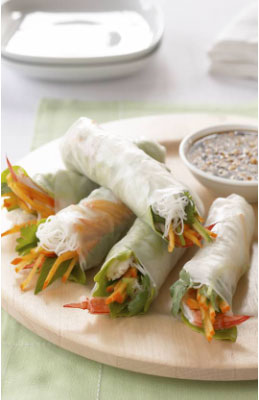Persimmon Prawn Rice Paper Rolls

Persimmon Prawn Rice Paper Rolls
Makes 8Ingredients
60gm dried rice vermicelli
8 16cm round rice paper wrappers
8 medium butter lettuce leaves, washed
8 large cooked king prawns, peeled, de-veined and sliced in half lengthways
24 fresh mint leaves
1 small firm persimmon, julienned
1 small Lebanese cucumber, julienned
24 fresh coriander leaves
Dipping sauce:
1 tablespoon Japanese rice vinegar
4 tablespoons hoi sin sauce
1 tablespoon unsalted peanuts, roughly chopped
Method:
1. Prepare rice vermicelli as per packet instructions, drain well.
2. Combine all sauce ingredients for dipping.
3. Place 1 rice sheet in warm water until just softened, remove from water place on clean, damp tea towel.
4. Lay a lettuce leaf over the wrapper, top with 2 pieces of prawn horizontally, 3 mint leaves, a little persimmon, cucumber, rice vermicelli and 3 coriander leaves.
5. Fold bottom of wrapper up over the filling, fold one side in, roll up tightly. Keep rolls under damp cloth while preparing remaining ingredients.
6. Serve with dipping sauce.

AUSTRALIAN FRESH PERSIMMONS
Fresh Australian sweet persimmons are fast becoming a fashionable choice amongst fruit and vegetable buyers in autumn with the fresh crisp and crunchy delectable taste just pure pleasure. With their versatility in the kitchen and the natural sweet tasting goodness it's not hard to see why they are climbing up the popularity ladder!The adaptability of this bright red-orange, sweet delight in the kitchen makes it an ideal pairing to sweet or savoury, hot and cold dishes, as well as a compliment to many snacks and finger foods.
The astringent variety of persimmons are perfect for a cheap and easy way to make your own sorbet. Make sure the fruit is well ripened, pop in the freezer, then when frozen slice the top off and spoon the frozen pulp right out of the skin - you can sprinkle some lemon or sea salt for added taste!
Don't forget, when selecting persimmons, the fruit should be brightly coloured, glossy and firm. The green calyx (the flower shaped cap) will become easy to remove as the fruit ripens. The appealing exterior hides a surprising centre - a unique star pattern, which is only visible when the fruit is cut horizontally.
They have high levels of vitamins A and C, as well as potassium, phosphorus and beta-carotene. These brightly orange glowing fruits contain virtually no fat - which makes them great snacks, that won't go straight to your hips!
Serving suggestions:
Persimmons are perfect to use as an ingredient, whether in hot, cold, sweet or savoury dishes as the flavour is not over powering making it subtle, sweet and delicious.
Did you know...
MORE
Copyright © 2001 - Female.com.au, a Trillion.com Company - All rights reserved. 6-8 East Concourse, Beaumaris, Vic 3193, Australia.



